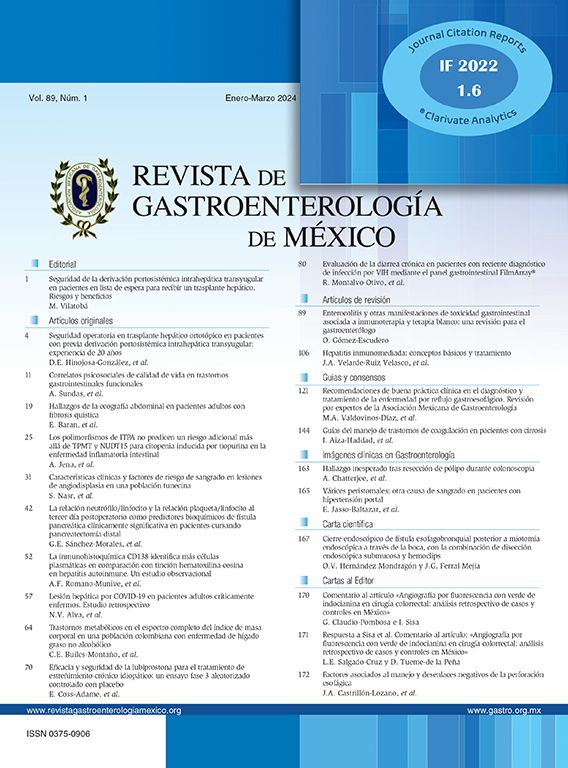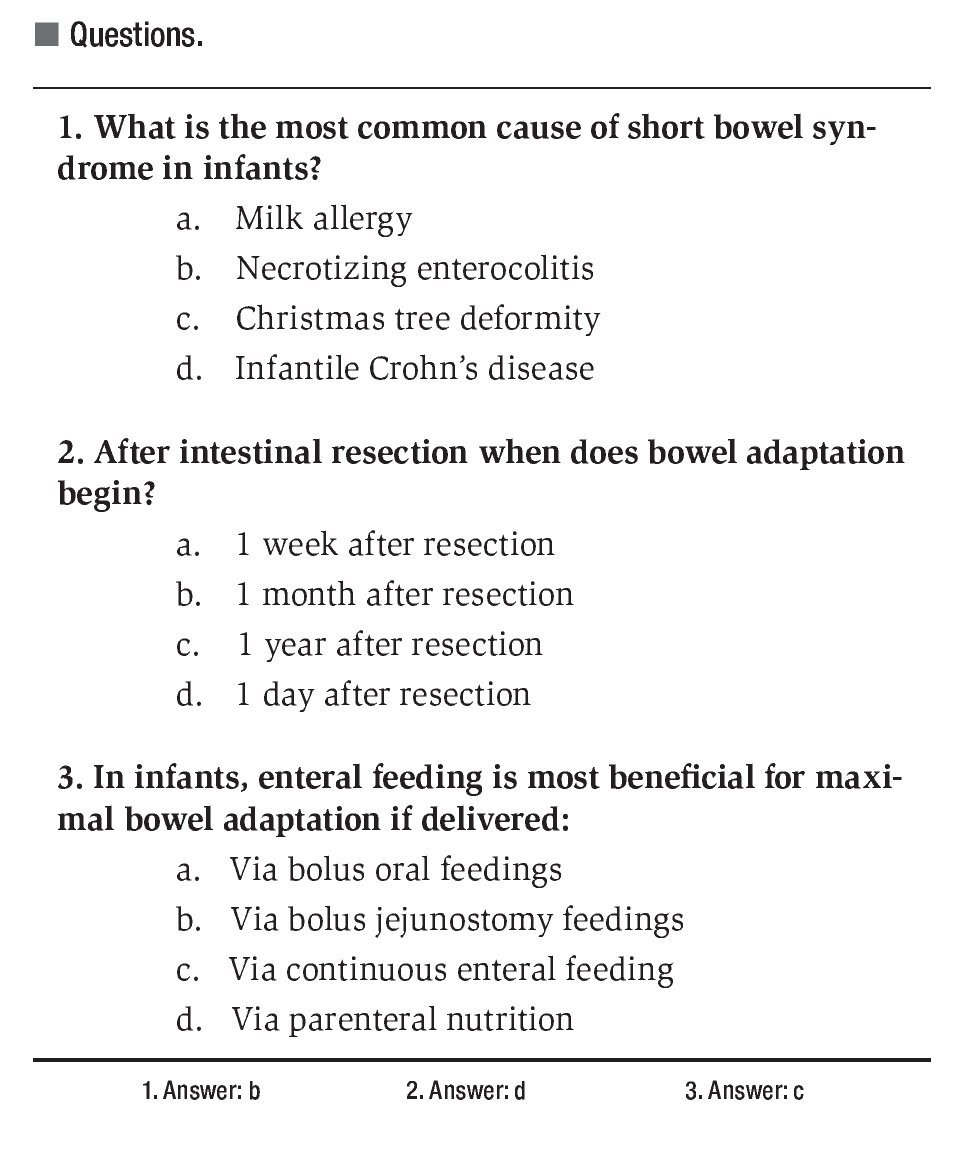Short bowel syndrome is not anatomically defined. The generally accepted functional definition of short bowel syndrome implies malabsorption of nutrients, fluids, and/or electrolytes in the presence of a shortened small intestine. Massive small bowel resection most often occurs in the neonatal period. The ileum and the colon are the most frequently resected; however, varying degrees of jejunal removal occur as well. The remaining small bowel begins to adapt almost immediately. The length of remaining bowel correlates poorly with the development of malabsorptive diarrhea. The remaining length of intestine, therefore, cannot be relied upon solely for determining prognosis, as many other factors such as innervation, hormonal effects, and bacteria present in the bowel will affect adaptation.
Parenteral nutrition was previously the mainstay of therapy permitting patients with shortened small intestine to live for extended periods of time beyond the functional capability of the remaining intestine. It has now been relegated to a supplementary role by improved enteral feeding techniques. Patients rarely suffer the complications of parenteral nutrition, but with the help of intense enteral nutrition techniques they often attain near-normal eating patterns as therapy progresses. Intestinal and liver transplantation have also become options for those previously unable to adapt completely to enteral nutrition allowing for discontinuation of total parenteral nutrition (TPN) and resolution of irreversible TPN-related liver disease.
¡ Etiology
Short bowel syndrome in children may occur either congenitally or more commonly may follow intestinal resection in anatomically normal infants. Congenital anomalies include congenital short bowel syndrome, atresias either isolated or multiple anywhere in the intestine , and gastroschisis with associated intestinal shortening. Meconium ileus or plugging may result in necrosis due to mechanical distention of the bowel. Volvulus may also occur, especially in children with rotational anomalies. The largest numbers of patients, however, are those children who undergo resection due to necrotizing enterocolitis. Conditions resulting in intestinal resection and short bowel syndrome in older children include Crohn's disease, tumors, radiation enteritis, and occasionally Hirschsprung's disease involving the small intestine.
Ideally, therapy for short bowel syndrome must be rooted in the knowledge of pathophysiological changes that result from resection of small intestine. The most obvious change is the overall loss of absorptive surface area; however, the inherent characteristics of the remaining small intestine are critical in determining the functional ability of the bowel to adapt. Most commonly, the ileum and colon are resected leaving a large portion of jejunum, often with only limited colon. The jejunal epithelium differs significantly from that of the ileum in that it is relatively porous allowing free and rapid flux of water and electrolytes. It is a primary site of nutrient absorption with characteristically long villi creating the large absorptive surface area. Retention of the colon generally enhances prognosis. The colon efficiently absorbs sodium, so sodium depletion is unusual unless the colon is either resected or not utilized. The colon also absorbs short chain fatty acids for an energy source, salvaging otherwise lost calories from malabsorbed carbohydrates.
The loss of the ileocecal valve results in greater flux of bacteria from the large to the small bowel. The valve also regulates the exit of fluid and malabsorbed nutrients from the small intestine and, although considered to be a major factor in regulating bowel transit, other adaptive changes often can compensate for its loss. Attempts to increase transit time with either medications or surgical procedures have often resulted in exacerbations of bacterial overgrowth. As bowel dilatation occurs during the adaptive process, gastrointestinal transit times from the stomach through the large bowel usually decrease over time.
¡ Clinical Management
In most instances, replacement of basic nutritional deficiency states, including proteins, vitamins, and minerals, is the initial role of the parenteral nutrition solution. The solution can often be a relatively standard mix providing nutrients and calories according to patient age and size. Replacement fluids can be prescribed by monitoring stool or ostomy output for electrolyte content and replacing the amount of fluid loss (cc by cc) according to losses accrued in the preceding two hours.
Enteral feeding is begun when fluid and electrolyte losses have declined. Most commonly, elemental diets delivered through a slow continuous enteral infusion are utilized permiting a greater percentage of total nutritional requirements to be delivered by the enteral route. Early enteral feedings are given to enhance intestinal adaptation, which begins within 24-48 hours following intestinal resection. Nutrients stimulate adaptation via direct contact with the mucosal epithelium. By increasing the workload of the epithelium, greater autocrine or paracrine secretion of trophic substances occurs which stimulates cell proliferation. Enteral nutrition also increases gastrointestinal secretions from the stomach, the liver, the pancreas, and the small intestine, which are trophic to the small bowel. Gastrointestinal hormones stimulated by enteral nutrition and secreted into the bloodstream also enhance adaptation. Numerous hormones such as enteroglucagon, neurotensin, epidermal growth factor, IGF-1, GLP-2, and even gastrin are likely involved. High levels of peptide YY may play a role in slowing gastric emptying as part of the "colonic brake" phenomenon.
Even in the infant who has undergone extensive intestinal resection, bolus nipple feedings in very small volumes of the prescribed enteral formula are utilized to simulate normal developmental stages of feeding. Oral electrolyte solutions may be substituted for enteral formulas or used to dilute the selected formula if the infant has high volume fluid losses. At any point, if stool losses are significant, nipple feeding may be discontinued. However, it may foster infant/caregiver bonding, which often normally occurs during feeding time.
Parenteral feeding is weaned proportionately to advancement of enteral nutrition. Compensation for malabsorbed enteral calories will alter the parenteral calories required. Caloric requirements are gradually altered, based both on the child's rate of growth and estimated caloric needs, to insure attainment of appropriate growth percentiles for both height and weight. Normal developmental stages of eating involving both chewing and swallowing should be initiated if the child is developmentally ready, even in those infants who may tolerate very few enteral calories or have enteral tubes in place. This entire process is very gradual and individualized, and may take months or years to complete.
¡ Complications
Initially, fluid losses and electrolyte imbalance are common in patients undergoing massive intestinal resection. Watery diarrhea is common due to excess osmotic fluid loads in the shortened small intestine. Switching from bolus to continuous enteral feedings, altering enteral formula type to a low carbohydrate-high fat formula, or diluting enteral formulas may be beneficial in diminishing output. Use of somatostatin and cholestyramine may help diminish the effects of secretory diarrhea. Loperamide has demonstrated safety in the pediatric age group and may be efficacious in slowing gut transit when taken an hour before meals.
Catheter-associated complications in the later phases of the clinical management of the patient with short bowel syndrome include puncture, catheter deterioration, occlusion, thrombosis, and sepsis. Causes of sepsis include both intrinsic factors such as bacterial translocation, malnutrition, and immune suppression and extrinsic factors such as a poor central line technique or lack of knowledge.
In the later phases of clinical management, small bowel bacterial overgrowth (SBBO) often occurs. Symptoms of SBBO include bloating, abdominal cramping, exacerbation of diarrhea, and/or weight loss. Bacterial overgrowth can also cause mucosal inflammation due to toxins produced by the bacteria and by the breakdown of bacterial metabolites. Severe complications of bacterial overgrowth include d-lactic acidosis, colitis, and inflammatory arthritis. These symptoms may be so severe as to require not only antibiotic therapy, but the use of anti-inflammatory drugs such as corticosteroids and salicylate products.
Nutritional deficiency states begin to occur when patients are free of parenteral nutrition. Acid peptic disease often occurs in pediatric patients with short bowel syndrome. Parenteral nutrition-related liver disease is a major cause of death in children with short bowel syndrome. The etiology is poorly understood and aggressive enteral nutrition, prevention of SBBO, and avoidance of catheter-related sepsis are all helpful in reducing parenteral nutrition-associated liver disease.
¡Surgical Issues
Surgical placement of enteral feeding tubes is often an ongoing surgical situation. Fundoplication is rarely necessary due to the development of acid peptic disease. Patients with short bowel syndrome who have undergone previous intestinal resection may develop anastomotic ulcerations and strictures requiring further bowel resection. Bowel dilatation often occurs during the period of intestinal adaptation. This adaptive response, while beneficial in increasing surface area, may become so extreme as to exacerbate SBBO. Identified on upper gastrointestinal/small bowel series, this problem may be alleviated using surgical tapering with or without concomitant lengthening (Bianchi procedure). Use of reversed small bowel segments and colonic interposition has been successful in some adult patients with short bowel syndrome but are less successful in children.
Pediatric small intestinal transplants are currently being done at several centers in the US. While short-term results often appear promising, long-term data suggest that overall survival with a good quality of life is little better than fifty percent. Combined liver/bowel transplantation is a potential option for patients with irreversible TPN liver disease and short bowel syndrome. Isolated intestinal transplants may have a much lower complication rate and should be considered before irreversible liver disease occurs.
Correspondence: Jon Vanderhoof. Boston, MA,
U.S.A. Vice President Global Medical Affairs. Mead Johnson Nutritionals Evansville IN, USA





